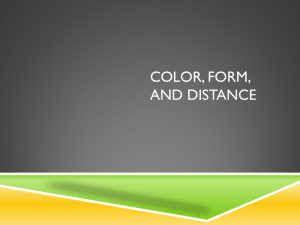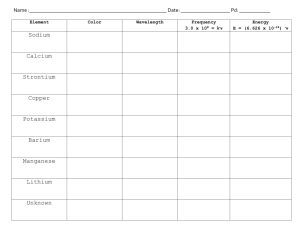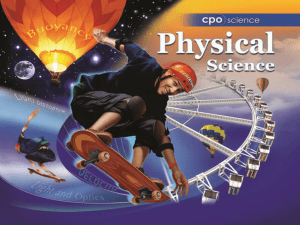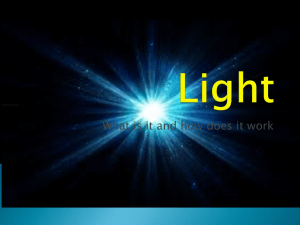File
advertisement
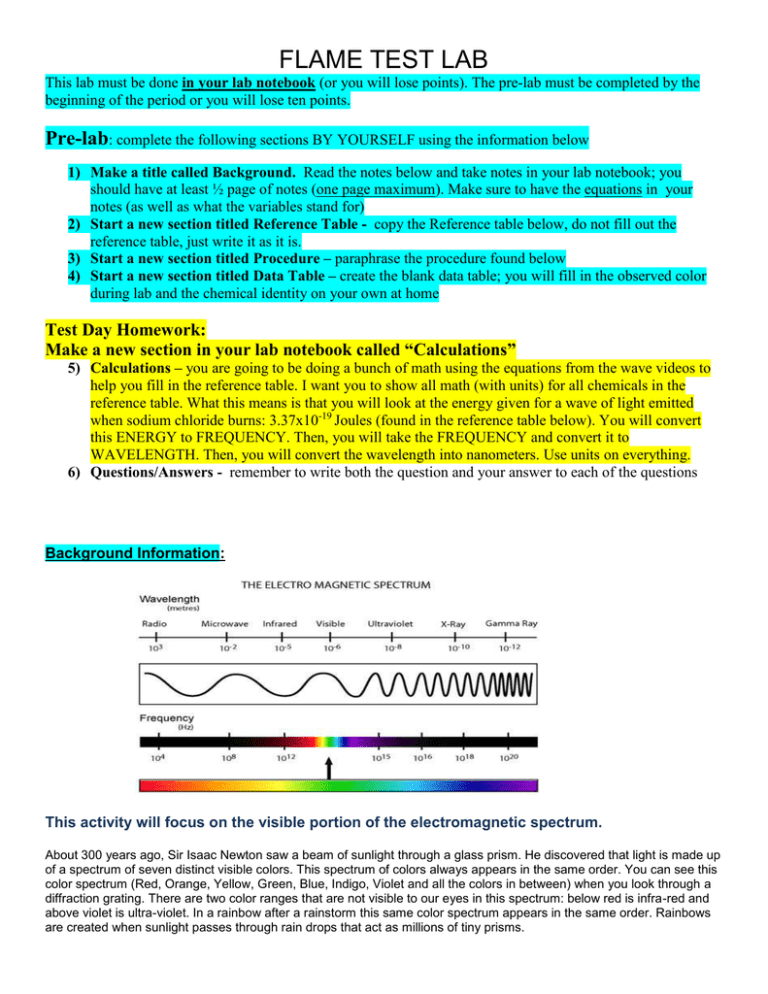
FLAME TEST LAB This lab must be done in your lab notebook (or you will lose points). The pre-lab must be completed by the beginning of the period or you will lose ten points. Pre-lab: complete the following sections BY YOURSELF using the information below 1) Make a title called Background. Read the notes below and take notes in your lab notebook; you should have at least ½ page of notes (one page maximum). Make sure to have the equations in your notes (as well as what the variables stand for) 2) Start a new section titled Reference Table - copy the Reference table below, do not fill out the reference table, just write it as it is. 3) Start a new section titled Procedure – paraphrase the procedure found below 4) Start a new section titled Data Table – create the blank data table; you will fill in the observed color during lab and the chemical identity on your own at home Test Day Homework: Make a new section in your lab notebook called “Calculations” 5) Calculations – you are going to be doing a bunch of math using the equations from the wave videos to help you fill in the reference table. I want you to show all math (with units) for all chemicals in the reference table. What this means is that you will look at the energy given for a wave of light emitted when sodium chloride burns: 3.37x10-19 Joules (found in the reference table below). You will convert this ENERGY to FREQUENCY. Then, you will take the FREQUENCY and convert it to WAVELENGTH. Then, you will convert the wavelength into nanometers. Use units on everything. 6) Questions/Answers - remember to write both the question and your answer to each of the questions Background Information: This activity will focus on the visible portion of the electromagnetic spectrum. About 300 years ago, Sir Isaac Newton saw a beam of sunlight through a glass prism. He discovered that light is made up of a spectrum of seven distinct visible colors. This spectrum of colors always appears in the same order. You can see this color spectrum (Red, Orange, Yellow, Green, Blue, Indigo, Violet and all the colors in between) when you look through a diffraction grating. There are two color ranges that are not visible to our eyes in this spectrum: below red is infra-red and above violet is ultra-violet. In a rainbow after a rainstorm this same color spectrum appears in the same order. Rainbows are created when sunlight passes through rain drops that act as millions of tiny prisms. The color of a solid object depends on the colors of light that it reflects. A red object looks red because it reflects red light and absorbs all other colors. A blue object looks blue because it reflects blue light and absorbs all other colors. A white object reflects all colors of light equally and appears white. A black object absorbs all colors and reflects no visible light and appears black. Just like when you color with too many colors in one area with crayons or markers, all colors are absorbed, none are reflected and it appears black! Explanation of visible light at the electronic level: What do fireworks, lasers, and neon signs have in common? In each case, we see the brilliant colors because the atoms and molecules are emitting energy in the form of visible light. The chemistry of an element strongly depends on the arrangement of the electrons. Electrons in an atom are normally found in the lowest energy level called the ground state. However, they can be "excited" to a higher energy level if given the right amount of energy, usually in the form of heat or electricity. Once the electron is excited to a higher energy level, it quickly loses the energy and "relaxes" back to a more stable, lower energy level. If the energy released is the same amount as the energy that makes up visible light, the element produces a color. Different elements produce different colors of light due to size differences; A larger atom has larger differences between energy levels. When electrons transition between energy levels that are farther apart, a photon with more energy is released. The visible spectrum, showing the wavelengths corresponding to each color, is shown below: Note: [1 Å = 0.1 nm] Is light a particle or a wave? Is light composed of waves or of particles? If light is waves, then one can always reduce the amount of light by making the waves weaker, while if light is particles, there is a minimum amount of light you can have - a single ``particle'' of light. In 1905, Einstein found the answer: Light is both! In some situations it behaves like waves, while in others it behaves like particles. This may seem odd. How can light act like both a wave and a particle at the same time? Consider a duck-billed platypus. It has some duck-like properties and some beaver-like properties, but it is neither. Similarly, light has some wavelike properties and some particle like properties, but it is neither a pure wave nor a pure particle. A wave of light has a wavelength, defined as the distance from one crest of the wave to the next, and written using the symbol . The wavelengths of visible light are quite small: between 400 mm and 650 nm, where 1 nm = 10-9 m is a ``nanometer'' - one billionth of a meter. Red light has long wavelengths, while blue light has short wavelengths. A particle of light, known as a photon, has an energy E. The energy of a single photon of visible light is tiny, barely enough to disturb one atom; we use units of “electron-volts”, abbreviated as eV, to measure the energy of photons. Photons of red light have low energies, while photons of blue light have high energies. The energy E of a photon is proportional to the wave frequency ʋ, E = hʋ where the constant of proportionality h is the Planck's Constant, h = 6.626 x 10-34 J s. Also, the relationship between frequency and wavelength can be defined as: ʋλ=c where c is the speed of light (3×108 meters per second). So photons still have a wavelength. A famous result of quantum mechanics is that the wavelength relates to the energy of the photon. The longer the wavelength, the smaller the energy. For instance, ultraviolet photons have shorter wavelengths than visible photons, and thus more energy. This is why they can give you sunburn, while ordinary light cannot. Spectra can be simplified to one of three basic types. Simple examples in the visible wavebands are shown below: Type of Spectrum Photographic example Continuous (or continuum) Absorption (dark line) Emission (bright line) The important thing to know about absorption and emission lines is that every atom of a particular element will have the same pattern of lines all the time. And the spacing of the lines is the same in both absorption and emission, only emission lines are added to the continuum, while absorption lines are subtracted. Reference Table: Chemical 1M solution Energy (E) in J sodium chloride 3.37x10-19 calcium chloride 3.06 x10-19 potassium chloride strontium chloride Frequency (ν) in Hz Wavelength (λ) in m Wavelength (λ) in nm Color 4.85 x10-19 2.94 x10-19 barium chloride 3.52 x10-19 iron(III) chloride* 3.43 x10-19 copper(I) chloride 4.23 x10-19 copper(II) sulfate 3.94 x10-19 * appears as sparkles in the flame Procedure: Color Wavelength Region (nm) Violet 400 – 425 Blue 425 – 480 1. Tie back hair (not optional); put on safety goggles (not optional) and a Blue-green lab apron (optional). Green 2. Light the Bunsen Burner at your beginning station (if it is not already Yellow-green lit). 3. To clean the nichrome wire, heat the wire in the hottest part of the flame Yellow until no color shows. Orange 4. Dip the nichrome wire into a small beaker of water. Red 5. Dip the clean nichrome wire in the solids on the well plate and hold it in the flame. Record your observation of the color of the flame in the data table. 6. Repeat step 5 if necessary to make an accurate observation. 7. Clean up any solids spilled by wiping them into the trashcan. 8. Move to the next station when the teacher indicates. Data Table: Station # Observed Color 1 2 3 4 5 6 Chemical Identity? 480 – 500 500 – 560 560 – 580 580 – 585 585 – 650 650 – 700 7 8 Questions & Answers: 1. What chemical emitted light with the highest energy? 2. What chemical emitted light with the lowest frequency? 3. Which chemical emitted light with the lowest wavelength? 4. How are electrons “excited” in this part of the experiment? What does it mean the electrons are “excited”? 5. Why do different chemicals emit different colors of light? 6. Suppose you were a firefighter and you were called to a chemical plant fire. Upon arrival you see a bright violet/purple flame. What chemical do you think is burning? Explain. 7. Using the information in your data table, design a firework and then predict what it would look like as it burns. Use a minimum of 3 chemicals… you want it to look cool! Think about what order they would burn based on the location of the fuse. Draw it onto the diagram below and explain.

